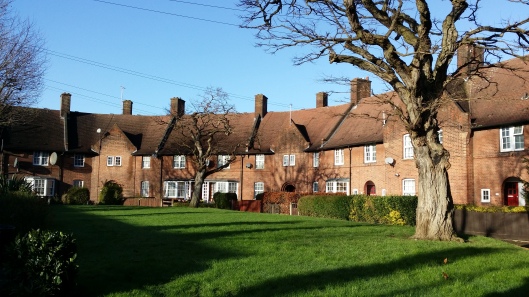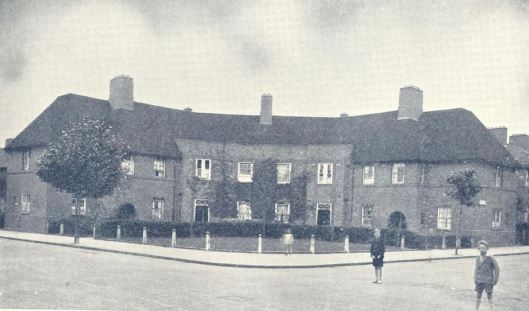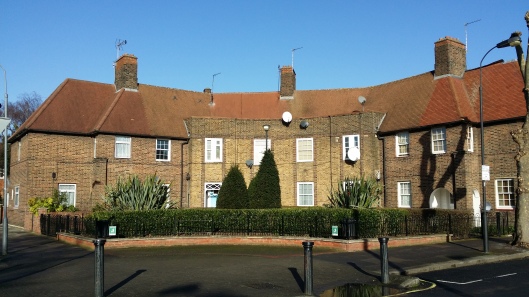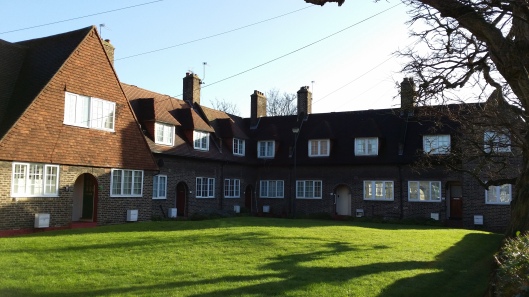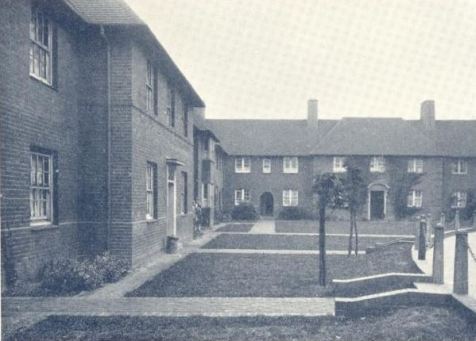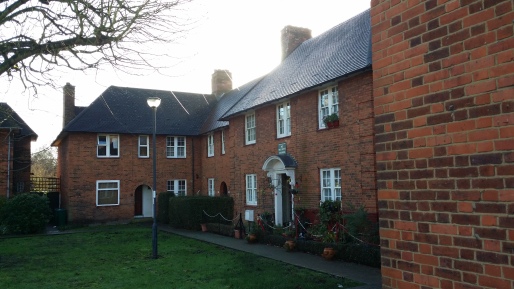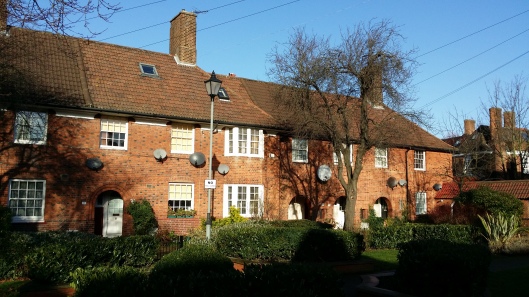Tags
Last week’s post left the Edward Woods Estate, just a decade into its existence, in a parlous state – criticised by the Borough which built it, unloved apparently by its residents, and with the range of problems coming to seem typical of such high-rise modernist schemes. Hammersmith and Fulham’s Director of Housing, Tony Babbage, had concluded that tenants had ‘started to reject the estate as a good place to live’. (1)

An undated photograph taken by Bernard Selwyn © Royal Borough of Kensington and Chelsea Archives
All pretty damning on the face of it but a reading of a tenants’ survey undertaken by the Council at this time allows more nuanced judgment. In practical terms, it shows some 66 pensioner households and around 50 with children living, contrary to declared policy, above the tenth floor in the three tower blocks. Surprisingly, however, ‘elderly people were the most satisfied with living on the estate’. They were also ‘the most likely to be happy living off the ground’ which people with families disliked because ‘they felt it was dangerous for the children’. (2)
Beyond that, ‘the main dislikes of the estate were the unreliable lifts, dirtiness, refuse chutes and the vandalism’. But, contrary to what you may have been led to believe, people liked ‘the homes themselves, the general location and the neighbours’.
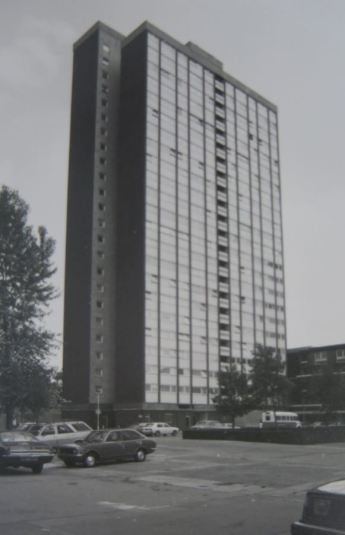
Poynter House, 1981 © London Borough of Hammersmith and Fulham Archives
What they wanted was simple. A quarter wanted improved security patrols (in other words they wanted to be and to feel safe), 14 percent wanted better cleaning, and 12 percent wanted an improved repairs service. The latter might seem a surprisingly low figure given that 40 percent of households had repairs outstanding and some 46 households had been waiting over six months for repair work to be carried out. You can draw your own conclusions but two things seem clear to me.
One, as we’ve seen in a diverse range of estates across the country, this was a period – for reasons I’ve never seen convincingly explained – when antisocial behaviour spiked. (Football hooliganism was another manifestation of the same malaise.) In housing terms, the obvious target of blame to many seemed to be the design of the new multi-storey, modernist estates – their lack of ‘defensible space’ and ‘natural surveillance’ in the jargon of the time and the design features – decks and stairways – held to facilitate crime. The simple fact that similar problems existed across a variety range of estates should lead us to question this widely-accepted conventional wisdom.

Stebbing House and play area in foreground, 2017
Two, residents were not in fact railing against the design of their homes but, for the most part, against poor maintenance and upkeep. Perhaps a 1979 Daily Telegraph report exaggerated but it concluded ‘that no stair cleaning had been done for weeks’ and on the lower floors, residents were ‘forced to negotiate rubble, broken glass and kitchen rubbish’. (3)
A further look of the Director of Housing’s report allows a different reading of the Estate’s problems, rooted far less in the systemic failure of an entire model of housing provision and far more in contemporary, specific and remediable deficiencies:
The tenants at large view with dismay what has happened to the estate. They feel very strongly about the estate itself. They take the view that the estate has been allowed to deteriorate rapidly.
Public housing budgets are always constrained and were to become catastrophically so in the 1980s but it’s also clear in this earlier period that some councils were failing to invest in basic upkeep and services.
If it took a crisis for that to become obvious, it’s only fair to report that at this point the Council began to act quite radically and systematically to put things right. By the end of the year, a local management team had been set up and £350,000 committed to replacing failing rubbish chutes, upgrading lifts and a range of other remedial work.
Two years later, the Estate was included in a new central government initiative, the Priority Estates Project, intended to promote local management and tenant participation in some of the most troubled estates across the country. In Edward Woods, this led to 528 flats being equipped with an entryphone system. A purpose-built Neighbourhood Office was opened in Boxmoor House five years later. (4)

Boxmoor House, 2017
The tide was turning. Elsewhere, there was already talk of the demolition of ‘failing’ tower blocks, particularly those with structural defects. But that for Peter Fox, Director of Housing, was a ‘sort of defeatism [he] could never contemplate’. Ideally, he would have liked ‘to do as they do in private blocks and install concierges, carpets and potted palms’ but he had, he said, to be realistic. (5)
That was a realism perhaps imposed by class attitudes as much as those financial pressures touched on but, in fact, a concierge scheme was introduced in Stebbing House in 1989 and they’ve since become common in social housing schemes. (6)
Such innovations were largely funded by the variety of area-based initiatives promoted by central government in the era. Finance – both Conservative governments to 1997 and the New Labour administrations subsequently cut local authority housing budgets – continued to limit what could be done and to dictate the form that regeneration took.
By 1998, it was estimated that the Estate required about ‘£7m worth of essential repairs and improvements’. Under the new financial regime and given what Stephen Burke, Hammersmith and Fulham’s deputy chair of Housing, described as ‘the prohibitively high costs of renovating Saunders House’, these could only be paid for by working with housing associations (whose funding was being boosted) and in partnership with private developers (7)

The current estate signs shows new layout and park
By 2003, the 58 homes of Saunders House and two garage podiums were demolished in order to allow the Notting Hill Housing Trust and Copthorn Homes (a subsidiary of Countryside Properties) to build 122 new homes for rent and sale. A new public park, Norland North, financed by Section 106 money (financial support for community infrastructure paid by developers as part of the planning permission process), was opened in 2009.
In the meantime, Labour’s Decent Homes Programme had been launched in 2000 – an initiative to improve estates and catch up with an estimated £19 billion backlog of needed repairs and refurbishments nationwide. It did not, however, provide the necessary funding to councils as such. Hammersmith and Fulham was forced – as were many similarly placed authorities – to establish an ALMO (an arms-length management organisation) which was permitted access to necessary funds.

Stebbing House with Boxmoor House in foreground, 2017
New kitchens and bathrooms in the tower blocks, extensive landscaping, redecoration, renewals and repairs across the Estate followed. The ALMO was wound up in 2010, having served its purpose, and management brought back in-house. New central heating systems were installed in tower block studio flats in 2011. The detail might seem trivial in itself (unless you were a beneficiary, of course) but it reminds us that continued investment maintains and fulfils the promise of decent and affordable housing which has lain at the heart of council housing since its inception.
So we’ve travelled some distance – from the promise of modernity to its dysfunctional fulfilment or, if you wish to employ some of the more colourful narrative language of the time, from dream to nightmare, utopia to dystopia. And we’ve come through that to something far better. Perhaps the conclusions we draw on the modernist council estates of the 1960s depend more at which stop we get off (to stretch the metaphor) and whether we are prepared to continue our journey forward.

A 3D Revit model of the estate © Terrain Surveys
The Edward Woods Estate continued that journey. The installation of new central heating in 2011 was part of a larger £16.13m low carbon refurbishment of the Estate headed by the Hammersmith and Fulham working with ECD Architects, the Breyer Group and insulation specialists Rockwool. The scheme was closely monitored and allows us to draw much broader conclusions about the Estate in the present.
It falls within the 12 per cent of most deprived areas in the country; the proportion of people on benefits is double the national average. It is home, disproportionately, to people from minority communities, almost one third are Black or Black British. Some 83 percent of homes are still council rented. When asked about the Estate, almost all residents felt safe in their homes and in the area; two thirds knew and got on with their neighbours. (8) With the refurbishment complete, the proportion of residents saying their quality of life was ‘good’ or ‘excellent’ rose from 68 percent in 2011 to 78 percent in 2015. (9)

The image of damage to Poynter House, prior to the installation of cladding, in December 2006 suggests how fire should be contained in high-rise blocks when systems are working effectively © Nico Hogg
The refurb included the addition of thermal cladding to the tower block exteriors. The tragedy of Grenfell Tower, which lies barely half a mile to the north, has cast a terrible shadow over such ‘improvement’ and caused Edward Woods residents severe alarm. Fortunately, in this case, the Council could report that the cladding used – fire-resilient stone wool insulation rather than the flammable panels used at Grenfell – passed all subsequent safety tests. (10)
I think this allows us to leave the final word with the redoubtable Anne Power: (11)
Established council estates can offer decent conditions, satisfied tenants, community stability, well-maintained buildings, high density, additional infill buildings and community facilities. Edward Woods estate in Hammersmith and Fulham meets all these conditions, while housing nearly 2000 almost entirely low-income council tenants.
The refurbishment, she concluded, had provided ‘High-Rise Hope!’ Perhaps that’s a story we can tell about the longer history of the Edward Woods Estate.
Sources
My thanks to the Archives and Local Studies service of the London Borough of Hammersmith and Fulham for many of the sources used to inform this post and for permission to use the images credited. They can be contacted at archives@lbhf.gov.uk.
My thanks also to Dave Walker at the Royal Borough of Kensington and Chelsea Local Studies and Archives for permission to use images in their holdings
(1) Hammersmith and Fulham Borough Council, Report of the Director of Housing, Edward Woods Estate W11: Initial Assessment (December 1979)
(2) Hammersmith and Fulham Borough Council, Edward Woods Estate Residents Survey (1979) [Edward Woods box file, Hammersmith and Fulham Archives and Local Studies]
(3) ‘Lift breakdown turn flat blocks into prisons’, Daily Telegraph, 31 August 1979
(4) The Centre – Oct ‘85’ [Edward Woods box file, Hammersmith and Fulham Archives and Local Studies]
(5) John Young, ‘Locking the Tower Block Door’, The Times, 30 April 1981
(6) Governing London, August 10 1989 [Edward Woods box file, Hammersmith and Fulham Archives and Local Studies]
(7) Michael Gerrard, ‘Bulldozers to demolish blocks for £7m facelift’, The Gazette, 31 July 1998
(8) Anne Power, ‘High Rise Hope’, LSE Housing and Communities, 19 October 2012
(9) Sustainable Homes, ‘Research on impact of large estate renewal in London revealed’, Blog, 28 July, 2015
(10) The H&F response to the Grenfell Tower fire, 20 July 2017
(11) Anne Power, ‘Council estates: why demolition is anything but the solution’, LSE British Politics and Policy, 4 March 2016







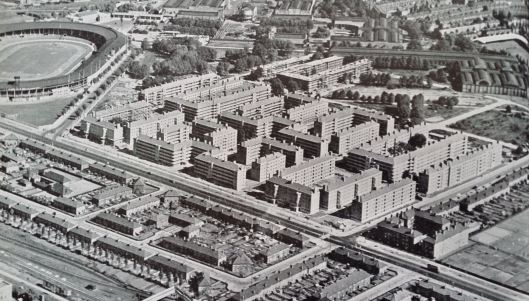









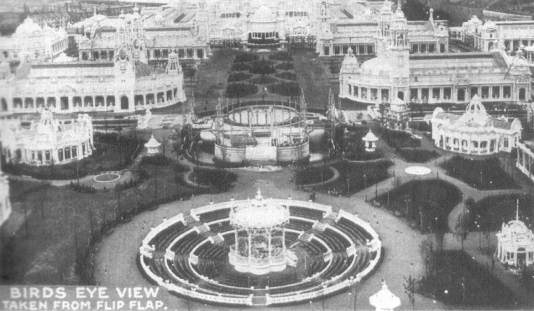




 almost qualify for the house-agents’ description ‘luxury flats’. They are approached by internal staircases, each of which has a dust-chute for disposing of rubbish. The flats with three, four or five rooms each have their private balcony, with permanent concrete window boxes. The kitchen has direct access to the living room through doors which slide wide apart.
almost qualify for the house-agents’ description ‘luxury flats’. They are approached by internal staircases, each of which has a dust-chute for disposing of rubbish. The flats with three, four or five rooms each have their private balcony, with permanent concrete window boxes. The kitchen has direct access to the living room through doors which slide wide apart.






 I want to say how proud I am to say I lived on the estate…There was a wonderful sense of community on this estate and the flats were a design success apart from the small kitchens. My memories of living here are of children – lots of children, all playing in safety and in harmony (well as far as kids do!).
I want to say how proud I am to say I lived on the estate…There was a wonderful sense of community on this estate and the flats were a design success apart from the small kitchens. My memories of living here are of children – lots of children, all playing in safety and in harmony (well as far as kids do!).